 Indians Archive
Indians Archive  2008 Indians Preview: The Infield
2008 Indians Preview: The Infield
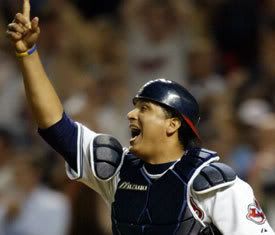 We continue with the third part of our annual preview of the Cleveland Indians today, and this time we take a deeper look at the Indians infield for 2008. For previous installments, click on the links below:
We continue with the third part of our annual preview of the Cleveland Indians today, and this time we take a deeper look at the Indians infield for 2008. For previous installments, click on the links below:
Part 1: The starting rotation
Part 2: The bullpen
Flashback: By the Numbers
The Indians have been a consistently good offensive team the last three years. With very little change in the lineup over the last several years, this trend should be expected to continue in 2008 as every member of the 2007 offense returns. While pitching has been the Indians strength since their revival in 2005, the offense has held their own and been in the top third in batting average, OPS, runs, home runs, and extra base hits in each of the last three seasons. Also, they have been one of the most patient teams in baseball, finishing 4th in walks in each year.
On the flip side, the Indians have also struck out a ton over the last three years, finishing in the top three in this category every year. While the Indians get points for their efforts in being more selective and patient at the plate, when you strike out at such a rate it sort of counteracts all the efforts to draw more walks. This is not the ideal way you work pitchers and draw walks.
As a comparison, Boston (1st) and New York (3rd) were ranked above the Indians last year in walks, and are the benchmarks when it comes to applying the selective approach at the plate of working counts and drawing walks. While the Indians had the third highest total in the league in strikeouts last year, Boston (9th) and New York (10th) strike out at a much lower rate. In fact, the Indians are very ordinary when you compare the Indians strikeout to walk ratio (K/BB) to other teams last year. Here is a listing of the KK/BB ratios for each team last year in the order of their rank:
1. Boston 1.51
2. New York 1.56
3. Minnesota 1.64
4. Oakland 1.69
5. Los Angeles 1.74
6. Baltimore 1.88
7. Toronto 1.96
8. Cleveland 2.04
9. Chicago 2.16
10. Seattle 2.21
11. Detroit 2.22
12. Texas 2.43
13. Kansas City 2.50
14. Tampa Bay 2.52
Also, one thing to note over the last three years is the home run totals decrease at a significant rate. The Indians were 5th in the league in home runs in 2006 with 196, but only hit 178 last year but were still ranked 5th. As a comparison, the Yankees were first in 2006 with 236 home runs, and were 1st last year even after dropping to 201 home runs. The major league team average for home runs dropped from 180 in 2006 to 165 in 2007. That is significant, as that is about 450 less home runs hit in 2007 compared to 2006.
Oh yeah, and the Indians are filled with a lineup of base-cloggers. Sure, manager Eric Wedge is not the type to put runners in motion with hit-and-runs or steal some bases, but the Indians still have been a bad base-stealing team under his watch. Here is a breakdown of the hitting statistics over the last three seasons, with AL ranks in parentheses:
| BA | R | HR | OPS | SB | K | BB | XBH | |
| 2007 | .268 (7th) | 811 (6th) | 178 (5th) | .771 (4th) | 72 (12th) | 1202 (3rd) | 590 (4th) | 510 (7th) |
| 2006 | .280 (4th) | 870 (2nd) | 196 (5th) | .806 (4th) | 55 (12th) | 1204 (1st) | 556 (4th) | 574 (1st) |
| 2005 | .271 (5th) | 790 (4th) | 207 (3rd) | .787 (4th) | 62 (11th) | 1093 (2nd) | 503 (4th) | 574 (2nd) |
| 3-YR AVG** | .273 (5th) | 824 (4th) | 194 (4th) | .788 (4th) | 63 (12th) | 1166 (2nd) | 550 (4th) | 553 (3rd) |
The 2008 Infield
The Indians return everyone that played significant time in the infield last season. The only real change this season from the start of last season is Asdrubal Cabrera has replaced Josh Barfield as the every day second baseman. With everyone back, the Indians look to bring some continuity to an infield unit that is not filled with All-Stars at every position, but as a group are a solid collection of performers both offensively and defensively.
While the Indians are much deeper in the pitching department, the Indians actually have some quality depth in the infield. The Indians will have Barfield stashed away at Buffalo this year and on call if anything happens to Cabrera or Jhonny Peralta. If Andy Marte still cannot establish himself at third base then Casey Blake will remain there all year. If anything were to happen to Victor Martinez, backup Kelly Shoppach is ready to assume an everyday role and Wyatt Toregas is about ready to be a major league backup. And, at first base the Indians have options aplenty with Ryan Garko, Travis Hafner, and Martinez, as well as prospects Jordan Brown and Michael Aubrey who will be in Buffalo.
The Indians infield is still very young and several players can be expected to improve. Peralta is still only 25, last year was the first full season for Garko, and Cabrera made his major league debut last year and is only 22. When you add Barfield and Marte to the mix, two prospects who have struggled but could still rebound, the Indians infield has the ability to become a much improved unit this season.
Here is the starting Indians infield:
C: Victor Martinez
1B: Ryan Garko
2B: Asdrubal Cabrera
SS: Jhonny Peralta
3B: Casey Blake
DH: Travis Hafner
Catcher: Victor Martinez
| AB | R | H | 2B | 3B | HR | RBI | BB | K | SB | AVG | OPS | RC | VORP | |
| 2007 | 562 | 78 | 169 | 40 | 0 | 25 | 114 | 62 | 76 | 0 | .301 | .879 | 109 | 55 |
 Martinez is clearly the emotional leader of the team. The picture of him at Fenway Park hanging over the dugout railing in full tears after the ALCS Game Seven loss to the Red Sox is an image that will last with many fans for years to come. Unlike past emotional leaders of the team, Martinez is also a pretty good hitter and considered one of the best catchers in baseball, if not the best.
Martinez is clearly the emotional leader of the team. The picture of him at Fenway Park hanging over the dugout railing in full tears after the ALCS Game Seven loss to the Red Sox is an image that will last with many fans for years to come. Unlike past emotional leaders of the team, Martinez is also a pretty good hitter and considered one of the best catchers in baseball, if not the best.
Martinez had a career year least season, setting career highs in doubles, home runs, RBI, and OPS. That said, it was not like his season came out of nowhere and that he had one of those anomaly type seasons where one year is such a big outlier compared to the rest. From 2004-2006, Martinez averaged a .302/20/94 season over those three years. Last year, he picked up the RBI slack while Hafner was stuck in a season long funk, and hit .356 with a .980 OPS with RISP and hit .400 with a 1.138 OPS with RISP and two out. He did wear down some in the second half, hitting only .273 with 9 HR, 46 RBI and a .811 OPS after the All Star break as compared to hitting .324 with 16 HR, 68 RBI and a .935 OPS before it.
While Martinez was doing all that hitting, it arguably was his improved defense which made a bigger impact. After teams ran at will against him in 2006 (18% caught stealing), he gunned down 32% of would be base-stealers last season and made what was a weakness in controlling the running game into a strength between him and Shoppach.
Martinez is one of the only hitters in the Indians lineup not prone to large strikeout totals. And, in case you did not notice he is not all that far away from free agency. While the talk is about re-signing C.C. Sabathia now, once Sabathia's contract situation is resolved for better or for worse after this season, the next player fans will begin to get uneasy about losing is Martinez after the 2010 season. For now, Martinez is the heart and soul of the team, and between him and Sizemore is someone the Indians cannot afford to lose for long in the lineup.
First Baseman: Ryan Garko
| AB | R | H | 2B | 3B | HR | RBI | BB | K | SB | AVG | OPS | RC | VORP | |
| 2007 | 484 | 62 | 140 | 29 | 1 | 21 | 61 | 34 | 94 | 0 | .289 | .842 | 72 | 27.8 |
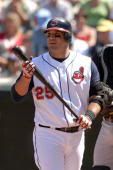 Last year was Garko's first full season, and overall he had a solid year offensively. Garko was a highly regarded hitting prospect who burst onto the season late in 2006 and put up monster RBI numbers in limited action where he basically averaged an RBI a game with 45 in 50 games played. Many might look at last season as a disappointment because he only increased his RBI total from 45 to 61 while playing in 88 more games; however, aside from the RBI numbers, his production did in fact increase some as he put up a .842 OPS compared to a .829 OPS in 2006. Also his extra base hit production improved from an XBH/AB of 9.74 in 2006 to 9.49 in 2007 (lower number is better), and his HR/AB increased from 26.4 in 2006 to 23.0 in 2007.
Last year was Garko's first full season, and overall he had a solid year offensively. Garko was a highly regarded hitting prospect who burst onto the season late in 2006 and put up monster RBI numbers in limited action where he basically averaged an RBI a game with 45 in 50 games played. Many might look at last season as a disappointment because he only increased his RBI total from 45 to 61 while playing in 88 more games; however, aside from the RBI numbers, his production did in fact increase some as he put up a .842 OPS compared to a .829 OPS in 2006. Also his extra base hit production improved from an XBH/AB of 9.74 in 2006 to 9.49 in 2007 (lower number is better), and his HR/AB increased from 26.4 in 2006 to 23.0 in 2007.
The reason why Garko struggled in the RBI department was a result of having an awful year hitting with RISP as he hit only .233 with a .697 OPS compared to hitting .353 with a .912 OPS with RISP in 2006. Given the way baseball statistics tend to regress to the mean, this season Garko likely will fall somewhere in the middle of those RISP stats from 2006 and 2007 and see improvement with driving in runs.
Garko does not look pretty defensively at first base, but he gets the job done. Considering the position was completely foreign to him a little over two years ago, he has made huge strides in adapting well to the position. Garko was just transitioned to the position full time two years ago, so to be an adequate first basement and make it through a full season last year is a testament to him being a hard worker. Garko is someone the Indians need to become more consistent and take on a more prominent role in driving in runs. As the 5th or 6th hitter in the lineup, he will get a lot of opportunities to drive in runs as teams pitch around Hafner and Martinez ahead of him.
Second Baseman: Asdrubal Cabrera
| AB | R | H | 2B | 3B | HR | RBI | BB | K | SB | AVG | OPS | RC | VORP | |
| 2007 | 159 | 30 | 45 | 9 | 2 | 3 | 22 | 17 | 29 | 0 | .283 | .775 | 27 | 7.6 |
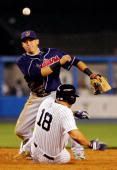 Cabrera started last season at Double-A Akron, made huge strides with his offensive game, was sent to Triple-A Buffalo for a handful of games and by August found himself in the middle of a pennant race as the starting second baseman with the Indians. Cabrera had been rushed by the Mariners organization to the Triple-A level, so in Cabrera's first full season in the Indians organization he started the year at Akron to work on his offense and become more confident with his approach. The plan worked, and he had one of the biggest breakthrough seasons for the Indians in the minors last year hitting a combined .310 with 8 HR, 57 RBI and an .828 OPS in 105 combined games at Akron and Buffalo before going to Cleveland.
Cabrera started last season at Double-A Akron, made huge strides with his offensive game, was sent to Triple-A Buffalo for a handful of games and by August found himself in the middle of a pennant race as the starting second baseman with the Indians. Cabrera had been rushed by the Mariners organization to the Triple-A level, so in Cabrera's first full season in the Indians organization he started the year at Akron to work on his offense and become more confident with his approach. The plan worked, and he had one of the biggest breakthrough seasons for the Indians in the minors last year hitting a combined .310 with 8 HR, 57 RBI and an .828 OPS in 105 combined games at Akron and Buffalo before going to Cleveland.
One of the things that impressed the Indians major league staff and the fans right away about Cabrera when they saw him play was the unusual amount of confidence he had and the way he carried himself at such a young age. In limited opportunities, he hit .318 with a .785 OPS with RISP (44 at bats) and when it was close and late he hit .500 with a 1.312 OPS (26 at bats). A shortstop by trade, he is a gold glove caliber middle infielder who has exceptional instincts, range, athleticism, footwork, and accuracy.
As a switch-hitter with decent speed and the ability to handle the bat well, he is a natural fit as a number two hitter in the Indians lineup. Eerily, he is a lot like former Indians great Omar Vizquel with his approach at the plate, base-running abilities, and wizardry with the glove. The only question with Cabrera is the offense, and if what he did in 2007 is the real thing, the Indians have a special player for many years to come where fans could be saying "Omar who?".
Shortstop: Jhonny Peralta
| AB | R | H | 2B | 3B | HR | RBI | BB | K | SB | AVG | OPS | RC | VORP | |
| 2007 | 574 | 87 | 155 | 27 | 1 | 21 | 72 | 61 | 146 | 4 | .270 | .771 | 86 | 26.3 |
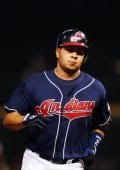 Besides Victor Martinez, if you want to point out one other player in the lineup who came up big last year and picked up the slack for others like Hafner who had subpar years, Peralta is the guy. Peralta had a very solid season last year and his improvement both offensively and defensively from 2006 to 2007 was a key to the Indians turnaround last year.
Besides Victor Martinez, if you want to point out one other player in the lineup who came up big last year and picked up the slack for others like Hafner who had subpar years, Peralta is the guy. Peralta had a very solid season last year and his improvement both offensively and defensively from 2006 to 2007 was a key to the Indians turnaround last year.
After a breakthrough performance in 2005 when he hit .292 with 24 HR, 78 RBI and a .886 OPS, Peralta slid big time both offensively and defensively in 2006 to where he hit .257 with 13 HR, 68 RBI, and a .708 OPS. He also looked slow, lazy, and not focused defensively in the field. Before the start of last season, Indians GM Mark Shapiro challenged Peralta to become more focused and he believed that if Peralta were to get his offensive and defensive numbers somewhere in between his 2005 and 2006 performance the Indians would take it and the team would benefit greatly from it. And, that is exactly what Peralta did, as Peralta hit .270 (.292 in 2005 and .257 in 2006), had 21 HR (24/13), 72 RBI (78/68), and a .771 OPS (.886/.708). Peralta carried his consistent play into the postseason and played very well on the big stage. He was clearly the Indians best hitter in the playoffs, hitting .333 with 2 HR, 10 RBI and a .991 OPS in 11 games.
Amazingly, Peralta is still only 25 years old and has a lot of time left for growth as a hitter and defender. People forget this, as he is not even close to maxed out potential. He has become more consistent defensively to where he is solid at the position, although as he gets older and bigger it is widely speculated he will need to move to third base. This is a possibility down the road, especially with third base looking vacant in 2009, and if Barfield rebounds this year he could be back in the plans at second base and Cabrera would move over to shortstop.
Third Baseman: Casey Blake
| AB | R | H | 2B | 3B | HR | RBI | BB | K | SB | AVG | OPS | RC | VORP | |
| 2007 | 588 | 81 | 159 | 36 | 4 | 18 | 78 | 54 | 123 | 4 | .270 | .776 | 69 | 17.6 |
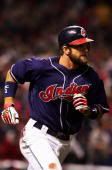 Blake is as consistent as they come. In his five seasons as an Indian from 2003-2007, his average season has been about a .262 batting average, 21 HR and 72 RBI. For a guy hitting ninth in the order, that is actually very good production. But, the reason Blake has made so many fans angry in the past, is he often struggles in tight situations and hitting with runners on base. His struggles started in 2005 when he hit a pathetic .171 with RISP and .085 with RISP and two out. He bounced back nicely in 2006, hitting .261 with RISP and .281 with RISP and two out, but last year once again slid to .190 with RISP and .163 with RISP and two out.
Blake is as consistent as they come. In his five seasons as an Indian from 2003-2007, his average season has been about a .262 batting average, 21 HR and 72 RBI. For a guy hitting ninth in the order, that is actually very good production. But, the reason Blake has made so many fans angry in the past, is he often struggles in tight situations and hitting with runners on base. His struggles started in 2005 when he hit a pathetic .171 with RISP and .085 with RISP and two out. He bounced back nicely in 2006, hitting .261 with RISP and .281 with RISP and two out, but last year once again slid to .190 with RISP and .163 with RISP and two out.
Aside from his troubles hitting in clutch situations, Blake is still a valuable player. Not only is he productive overall hitting ninth in the order, but he is very versatile where he can play any corner infield or outfield spot. When the Indians needed to make room for Aaron Boone at third base in 2005, Blake moved to right field. When Andy Marte struggled at third base last year, Blake moved back to third base without skipping a beat.
Blake is getting up there in age, as he is already 34 years old and turns 35 late in the season. He is a free agent at the end of the season, and given his age and price tag the Indians are unlikely to retain him unless he ends up not being as expensive on the open market as anticipated. With Marte (or Peralta) a possibility at third base next year, and Franklin Gutierrez, Ben Francisco, Trevor Crowe and David Dellucci likely the main outfield mix at left field and right field, there likely will not be a starting spot open for Blake. Blake could serve as a very valuable super utility player off the bench playing almost any day, but at what cost is the question.
Designated Hitter: Travis Hafner
| AB | R | H | 2B | 3B | HR | RBI | BB | K | SB | AVG | OPS | RC | VORP | |
| 2007 | 545 | 80 | 145 | 25 | 2 | 24 | 100 | 102 | 115 | 1 | .266 | .837 | 94 | 30.7 |
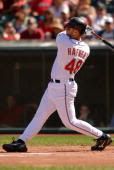 For most players, reaching the 100 RBI plateau in a season means they had a successful season; however, because of the standards Hafner has established in the past his 24 HR and 100 RBI season last year was very ordinary. Hafner, the Indians, and the fans have come to expect a lot more and he needs to get back to being the fearsome hitter he was from 2004-2006 when he averaged a .308 batting average, 34 HR, 111 RBI and an OPS around 1.000 a season.
For most players, reaching the 100 RBI plateau in a season means they had a successful season; however, because of the standards Hafner has established in the past his 24 HR and 100 RBI season last year was very ordinary. Hafner, the Indians, and the fans have come to expect a lot more and he needs to get back to being the fearsome hitter he was from 2004-2006 when he averaged a .308 batting average, 34 HR, 111 RBI and an OPS around 1.000 a season.
His fall last year is concerning, and one has to wonder if the contract situation plagued him with negotiations weighing him down in the beginning of the season and then after signing if he was pressured by having to live up to the contract. Hafner also may not have been completely healthy from the hand injury he suffered at the end of 2006. He also is 30 years old now, so hopefully last season was not the beginning of a sharp decline. In any case, it it tough to pinpoint what his problem last year was beyond him just not being comfortable at the plate. He actually struck out at a lower rate than in previous years, but he was just not getting quality swings on pitches where he was rolling pitches over more. He hit a lot more groundballs last year where his groundball to flyball ratio (G/F) jumped to 1.58 last year when in previous years it was right around 1.00. He hit 132 flyballs in 2006 and 133 in 2007, but his groundballs jumped from 136 in 2006 to 210 in 2007.
Hafner is the most important player to the offense this year. Since the Indians did not go out and upgrade left field in the offseason with a big bat, Hafner and Martinez will be relied on once again to be big producers in the three and four hole of the lineup. Especially Hafner.
Reserve: Josh Barfield, 2B
| AB | R | H | 2B | 3B | HR | RBI | BB | K | SB | AVG | OPS | RC | VORP | |
| 2007 | 420 | 53 | 102 | 19 | 3 | 3 | 50 | 14 | 90 | 14 | .243 | .594 | 42 | -13.6 |
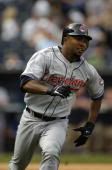 Barfield was a huge disappointment for the Indians last year. After he had a good rookie year in a noted offensive graveyard at Petco Park in San Diego, when the Indians acquired him in a November 2006 trade many felt he would flourish in the more friendly confines of Jacobs Field. The Indians thought they were getting a good young offensive second baseman who would be a core piece of the team for the next several years.
Barfield was a huge disappointment for the Indians last year. After he had a good rookie year in a noted offensive graveyard at Petco Park in San Diego, when the Indians acquired him in a November 2006 trade many felt he would flourish in the more friendly confines of Jacobs Field. The Indians thought they were getting a good young offensive second baseman who would be a core piece of the team for the next several years.
Unfortunately, Barfield never settled in and was hardly the heralded prospect and upper tier second baseman he had been made out to be. He was often lost at the plate and had a hard time adapting to the Indians philosophy of making pitchers work (14 walks!). Barfield was the definition of a hacker, and was brutal. The Indians finally gave up on him for the season and called up Cabrera in August, and he sat and watched as Cabrera solidified himself as the second baseman for the near future with good play all the way through October.
It is tough to understand what happened to Barfield. From 2006 to 2007, his doubles dropped from 32 to 19 and his home runs dropped from 13 to 3. He has never been a player who draws a lot of walks, but his sudden evaporation in slugging was puzzling, especially considering he was out of Petco Park. It is possible he had a hard time making the adjustment to the AL and also never really relaxed because he wanted to impress the team and fans after they traded for him. Whatever the issue, Barfield will get a chance to take a step back, relax, and get his career turned around in Buffalo this year. It worked for Brandon Phillips a few years ago after a disastrous season in Cleveland in 2003, so maybe the same works for Barfield this year.
Up Next: The Outfield and Bench

- NBA Announces 2013-2014 Schedule
- Browns Ink Sharknado
- Sharknado A No-Show For Rookie Camp
- Trent Richardson Out Until Training Camp
- Browns Sign Brandon Jackson
- Carrasco Suspended Eight Games
- Browns Add to Wide Receiver Depth with David Nelson
- Browns Need to Learn from Past Draft Mistakes
- Browns Release Chris Gocong and Usama Young
- Browns Missing on Grimes Disappointing, But Not The End
The TCF Forums
- The 2014 Offseason Thread
skatingtripods (Tuesday, January 21 2014 11:52 AM) - Official- Browns Coach Search/Rumors
Nicastro13 (Tuesday, January 21 2014 11:45 AM) - Chris Grant's first 3 drafts
Kingpin74 (Tuesday, January 21 2014 10:13 AM) - 2015 Recruiting
furls (Tuesday, January 21 2014 6:57 AM) - Mike Brown
YahooFanChicago (Monday, January 20 2014 11:15 PM) - Movies coming out
HoodooMan (Monday, January 20 2014 9:34 PM) - 2014 Hoops Hockey Hijinx
jpd1224 (Monday, January 20 2014 4:44 PM) - 2014 Recruiting
jclvd_23 (Monday, January 20 2014 2:26 PM) - Wish List - #4 Pick
Hikohadon (Monday, January 20 2014 1:26 PM) - #1 overall pick Anthony Bennett
TouchEmAllTime (Sunday, January 19 2014 1:28 PM)



